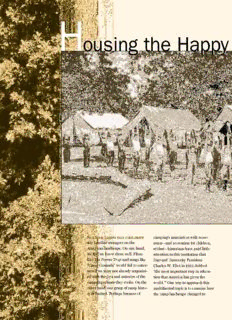
Housing the happy camper / Abigail A. Van Slyck. PDF
Preview Housing the happy camper / Abigail A. Van Slyck.
H oouussiinngg tthhee HHaappppyy SSuummmmeerrccaammppssffoorrcchhiillddrreenn camping’sassociationwithrecre- arefamiliarstrangersonthe ation—andrecreationforchildren, Americanlandscape.Ononehand, atthat—historianshavepaidlittle wefeelweknowthemwell.Films attentiontothisinstitutionthat likeTheParentTrapandsongslike HarvardUniversityPresident “CampGranada”wouldfailtoenter- CharlesW.Eliotin1922dubbed tainifwewerenotalreadyacquaint- “themostimportantstepineduca- edwiththejoysandmiseriesofthe tionthatAmericahasgiventhe campexperiencetheyevoke.Onthe world.”1Onewaytoapproachthis otherhand,ourgraspofcamphisto- multifacetedtopicistoexaminehow ryislimited.Perhapsbecauseof thecamplandscapechangedto CCaammppeerr ABIGAIL A. VAN SLYCK accommodateevolvingtheoriesof resorthotels,andnationalparks, Canvaswalltentsformabackdropfor childhoodandchildrearing. summercampsofferedurbandwel- earlymorningexercisesatSquareLake Minnesota,withitsgreatvarietyof lerscontactwithnature,whichwas BoyScoutcamp,ca.1925 publicandprivatecamps,provides believedtobeanimportantantidote anidealsettingforthiskindofstudy. totheevilsoftheindustrializedcity. Summercampsbeganasonecom- Forchildren,suchcontactwascon- ponentofaback-to-naturetrend sideredparticularlyimportant. thatdevelopedinAnglo-American Indeed,Victorianideologyheldthat cultureinthelastquarterofthenine- thecitythreatenedtheveryphysical teenthcentury.Likeurbanparks, healthofchildrenandtheirmothers. residentialsuburbs,campmeetings, Attheturnofthecentury,boththe Summer 2002 69 ColonialRevivalstyleandtheArts ofcommunicablediseasessuchas inhisview,wasaseriesofnatural andCraftsmovementfurthercele- tuberculosisand,later,polio.Then, stages,eachcrucialtohealthand bratedthesimplelife,closetonature, inthe1930sand1940s,childpsy- wellbeing.Youngchildren,he foritspatrioticandaestheticquali- chologyhadanevenbiggerimpact argued,werestillsavages—quite ties,andprogressiveeducational onthecampenvironment,shifting literally—andshouldnotbeforced theoryarguedthatcontactwith concernawayfromtheillsthat toadoptthecivilizeddemeanorex- naturewascrucialtothechild’s affectedallmodernchildrenand pectedofthemathomeandatschool, socialdevelopmentandpsychologi- towardspecificbehaviorproblems feminizedinstitutionsthatwerea calhealth.Reformersexperimented caused,itwasbelieved,bytheun- particularthreattothehealthy withawiderangeofactivitiesaimed scientificparentingthatcampers developmentofboys.In1908Hall athelpingcitychildrenofallclasses receivedathome. decried“theundueinfluenceof experiencenature.Theytriednature- Thesedevelopmentshadimpor- womenteachers”andstatedflatly studyclasses,schoolgardens,and tantgenderimplications.Thecri- that“thecallowfledginginthepin- daytripstorecreationpiersorswim- tiqueofthehomealsocensuredlate featherstageoftheearliest’teens mingbargesbutcametofavorthe Victorianmotherhood;bycoddling whomtheladyteacherandthefond summercampasthebestmeansof theirsons,mothershadundermined mothercantrulycallaperfectgen- immersingchildreninnature.2The vigorousmanhoodandcreatedwhat tlemanhassomethingthematter conditionsthatattractedsomany manymiddle-classmenperceivedas withhim.”4Thesummercampas VictorianfamiliestoMinnesota’s acrisisinmasculinity.Ashistorian amoderninstitutionwascalled grandsummerresortsinthenine- T.J.JacksonLearshaspointedout, intobeingbyanxietiesaboutboys. teenthcenturymadethestatean maleobserversattheturnofthe Althoughcampsforgirlsexistedin idealsettingforthisnewkindof centurybecameincreasinglyanxious theearlypartofthecentury,the experienceinwhichchildrenlived about“adeclineofvitalenergyinart needsofboysdominatedpublic apartfromtheirfamiliesforperiods andlife...theytracedenervationto discussionabouttheformandrole rangingfromafewdaystotenweeks. feminizationbecausetheyequated ofcamp. Twentieth-centurysummercamps masculinitywithforcefulness.”3 Althoughcampdirectorsmayhave quicklymovedawayfromtheirVic- Alongwithcamping,anumberof beenwaryofHall’sdirectattackson torianroots.Earlyinthecentury,the turn-of-the-centuryculturalpheno- mothers,whooftenmadethecamp- Victoriantriadofhome,health,and mena—arenewedinterestinArthu- ingarrangementsfortheiroffspring, naturebegantounravelastwosci- rianlegend,TheodoreRoosevelt’s theycertainlyknewhisworkand entificfieldshelpedconvincecamp RoughRiders,anewmaniaforfoot- oftenquotedhimdirectly.Organizers organizersthatanaturalsetting— ball—canbeseenasattemptsto commonlypromotedcampasthe whilebeneficial—wasinsufficientto reasserttheimportanceofrobust antithesisoftheordinary,tradition- guaranteegoodhealth.First,inthe masculinityinAmericanlife. boundschoolandcelebratedcamp 1910sand1920s,thenewfieldof Theseconcernsweresimultane- asasitewherelifeandlearningwere publichealthhighlightedthedan- ouslyfocusedonyoungerboysand entirelyintegrated,wherethecur- gersassociatedwithbringingtogeth- givenscientificcurrencybypsychol- riculumwassetbythecampersthem- eranygroupofpeopleforextended ogistG.StanleyHall,whoenvisioned selves,wheresyntheticlearningwas periodsoftime—evenincamp—and childdevelopmentastherecapitula- notartificiallypostponeduntilindi- focusedconcernonthetransmission tionofhumanevolution.Childhood, vidualelementshadbeenanalyzed, andwhereconnectionsbetweenaca- demicsubjectsbecameself-evident.5 AbigailA.VanSlyckistheDaytonAssociateProfessorofArtHistoryatConnecticutCollege Inshort,howevermuchthesum- andtheauthorofFreetoAll:CarnegieLibrariesandAmericanCulture,1890–1920(1995). mer-campideawasdrivenbyaback- HerarticleonmealtimeritualsatAmericansummercampswillappearinTechnology andCultureinFall2002. to-naturesentiment,thecamps 70 Minnesota History themselvesneverprovidedasimple, unmediatedoutdoorexperience.At anygivenmoment,theirplanning andarchitecture,theirprogramand activities,andtheirself-promotion, especiallyphotographsandbrochures, werecloselyrelatedtochangingper- ceptionsofchildrenandtheirneeds. Sincetheseperceptionsoftenwent unarticulated,acloserlookatthe camplandscapecanofferinsights intomodernchildhoodthatcannot begleanedfromwrittensources alone. Minnesota’scontributionto thesummer-campmovementmay notbeimmediatelyapparent.Initial- Manlycampskills,drawnbyGordonGrantfortheBoyScoutsofAmerica’s ly,NewEnglandplayedthekeyrole. HandbookforBoys,firstpublishedin1910 Theearliestcampswerethere;infact, until1905onlyahandfulofthecoun- try’s700privatecampsstoodoutside theregion.By1920theNewYork earliervolume,SummerCamps— Wapogasset,nearAvery,Wisconsin; areahadbecomeanimportantcenter BoysandGirls.Aslateas1930a privatecamps,likeCampLincoln, foragencycamps,thankstothenum- memberoftheMidwestsectionofthe aboys’campestablishedonLake berofyouthorganizations—Boy CampDirectorsAssociationbristled HubertnearBrainerdin1909; Scouts,GirlScouts,CampFireGirls, whenhiseasterncolleagues“came campsorganizedbytheBoyScouts YMCA,andYWCA—thatestablished outtotelluswhatwaswhat.The (likeCampWildernessestablished headquartersinManhattan.Thus, insolenceofthatposition—thatNew onBadAxeLakenearParkRapids whetherwelooktoarticlesinAssoci- Yorkhadthesophisticationandthat in1946),GirlScouts(likeCamp ationBoys,theYMCA’sjournalabout thecountrybumpkinsfromtheWest LakamagaonBigMarineLakenear “boys’work,”ortoseminalbookslike shouldautomaticallyadheretothe MarineonSt.Croix,establishedin HenryW.Gibson’sCampingforBoys, NewYorkleadgreatlyantagonized 1927),andCampFireGirls(like mostoftheearly-twentieth-century theMidwestgroup.”6 CampOjiketa,establishedin1926 literaturedescribedthephilosophy Minnesotansinparticularhad onGreenLake).Minnesotahasalso andmanagementofEastCoastcamps. everyreasontoresentthistreat- hadreligiouscampsofallsorts,like Evenpublicationsthatpromised ment.Summercampsofallkinds CampTikvah,establishedonLong nationalcoveragegaveonlyscant havedottedthestate’slandscape Lake,AitkinCounty,inthe1930sby attentiontoMinnesotaandotherareas sincetheearlydecadesofthetwenti- theMinneapolisJewishCommunity oftheMidwestandWest.HenryWel- ethcenturyandhaveservedcampers Council(nolongerextant);theLu- lingtonWack,forinstance,touched fromawiderangeofsituations. theranCampEmmaus,established onMinnesotacampsinhis1925 TherehavebeenYMCAcamps,like onMorganLake,CookCounty,in eugenicisttract,TheCampingIdeal, CampIcaghowan,begunin1908on 1934;CassLakeEpiscopalCamp, TheNewHumanRace,butonlyafter GreenLake,nearChisagoCity,and establishedin1935;andCatholic ignoringtheMidwestentirelyinhis nowoperatingontheshoresofLake YouthCamponBigSandyLake, Summer 2002 71 Large,airyBoyScoutdininghall,about1925 AitkinCounty,establishedin1946. organizerslivedintheEast.George revealthatthestate’scamporganiz- Finally,therehavebeensettlement- F.“Doc”Green,forinstance,who erswereneitheroblivioustolarger housecamps,likeWellsMemorial foundedCampMishawakaonLake debatesthatengagedtheireastern Camp,establishedonLakeMinne- PokegemanearGrandRapidsin counterparts,norblindfollowersof tonka’sTonkaBayin1922(nolonger 1910,wastheathleticdirectorof NewEnglandorNewYorkideas. extant);healthcamps,liketheVisit- St.Alban’s,theNationalCathedral Instead,theyconfrontednational ingNurseAssociationcampfor SchoolinWashington,D.C.,and issuesintheirownway. childrenwithtuberculosisthatoper- maintainedawinteraddressinthe Manyelementsofthecamp atedinGlenwoodParkinMinneap- federalcapitaluntilhisdeathin olisinthe1920s;and,morerecently, 1933.Otherdirectors,likeGreen, landscapeplayedaroleinproducing campsforchildren(andadults)with belongedtotheCampDirectors healthycampers.Fromthebegin- specialneeds,likeCampCourage, Association(CDA)and,later,toits ning,adviceliteratureemphasized establishedin1955onCedarLakein successor,theAmericanCamping theimportanceofgooddrainage,an Minneapolis. Association,andthuswerepartof amplesupplyofpotablewater,and Whatismore,geographicaldis- thenationwideprofessionalnetworks carefulattentiontocampsanitation. tancefromNewEnglandandNew thatbecameincreasinglycommonin Theneedforabundant,wholesome Yorkwasneversynonymouswith thecampingworldduringthetwen- foodmadethekitchenanddining ignoranceofcurrentcampingde- tiethcentury.7Thebuildingsand hallimportantsitesformaintaining bates.SomeofMinnesota’scamp landscapesofMinnesotacamps andimprovingacamper’sphysical 72 Minnesota History condition,whiletheinfirmary encampmentsthatoftenbeganon alsodescribedindetailhowtoerect becameanexpectedfeatureofa borrowedland.And,asfarasearly them,commentingonguyingthe healthycamplandscapeinthe campleaderswereconcerned,even tents,trenchingaroundthem,the 1920s.Yet,inmanyrespects,camper small,crowdedtentsposednothreat rightandthewrongwaysofdriving sleepingaccommodationswereseen tothecampers’physicalwellbeing. stakesintotheground,andother asthemostimportantelementfor In1902,whenGeorgePeckreflected elementsofwhathecalled“tentwis- securinggoodhealth.Giveninher- on“ThingsLearnedinSeventeen dom.”Butnowheredidheaddress itedVictorianconvictionsaboutthe ConsecutiveSeasonsinOneBoys’ thetentasapotentialhealthhazard. vulnerabilityofthesleepingbody, Camp,”herecommended“small Onthecontrary,thecaptiontoone thetentorcabinwaspotentiallythe tents,holdingfromfivetoteninall illustration,“‘TheSardines’—Eight mosttreacheroussiteincamp.8Itis [because]thisplanprovidesforthe Boysina12x14Tent,”suggeststhat theelementthatwastransformed bestcontrolandcareoftheboys.” helookedwithafondeyeontents mostdramaticallybychangingideas HenryW.Gibson,thedirectorof crowdedwithhappycampers.9By aboutwhatconstitutedahealthy YMCACampBecketinMassachu- providinganimitationofamilitary camper. settsfrom1903until1927,concurred. encampment,thetentwasanatural Intheearliestdecadesoforgan- Inhis1911bookCampingforBoys, choiceforcamporganizersbenton izedcamping,tentsweretherule. herecommendedwalltents,rectan- introducingmiddle-classboystoa Theywererelativelycheap,particu- gulartentswitharidgepolesup- masculineworlddeniedthemin larlyifprocuredfrommilitarysur- portedbyuprightpolesfrontand feminizedhomes. plus.Theyweremovable,animpor- backandhavinglowsidewallsof Periodphotographsrevealthat tantconsiderationforsummer canvassecuredbyguyropes.He tentcampingwascommonplacein Minnesota,whetheratearlyYMCA campslikeCampRedTop,organ- “TheSardines,”atentfullofhappycampersatYMCACampBecket,Massachusetts, izedbytheMinneapolischapter,or about1910 atprivatecampslikeMishawaka.In Mishawaka’sfirstseasons,campers sleptintentsthatlinedtheparade ground,colloquiallycalled“thecam- pus.”In1916,Greenestablisheda separatesleepingarea,theJunior Camp,foryoungerboys(between9 and11yearsofage),buttentswere stilltherule.Olderboysslepttwo toatent,whilethejuniorswere deemed“solittlethatitisnecessary thatacounsellorsleepineachtent withthetwoboys.”10 Attitudestowardthetent begantochangeinthe1920sas campdirectorsfoundtheirprofes- sionalaspirationsthwartedby regionaldifferencesandthetensions betweenprivateandagencycamps thatunderminedthesuccessofthe Summer 2002 73 nationalCDA.11Reorganizationas whicharekeptaccessibletothose squarefeetoffloorspaceand500 theAmericanCampingAssociation havingchargeofthephysicalsideof cubicfeetofairspacepercapita, in1935helpedovercomethesefac- campwork.Aphotographisalso whichbecametheoften-invoked tionaldifferences,butthroughout takenofeachboy,andwhichiskept camping-industrystandard.Equally the1920scampdirectorslookedto onhand,unretouched,toshowthe important,thestudyrevealedthat, othermeansofassertingtheirclaims generalconditionoftheboy. ofthe163campssurveyed,only31 toprofessionalstatus.Mostexpressed Then,ontheverylastdaysof the metthestandardwhileanother32 aheightenedconcernwithcamper season,allofthisworkisduplicat- housedcampersinhalftherecom- health,simultaneouslygivingtheir ed,sothatacomparativerecordis mendedamountofspaceorless. vocationascientificbasisandequat- madeofeveryboy,showinghiscon- Whileitmighthavebeenpossible ingcampdirectingwiththeprofes- ditionandmeasurementsatthe tocontinuetousetentsbyhousing sionofmedicine. beginningandatthecloseofthe fewercampersineach,therewere Manydirectors,likeDocGreenof season.12 otherhazards.Tentsweredifficult Mishawaka,turnedtheirattention tokeepdry;theydrippedduring toquantifyingthepositiveimpact Thesebefore-and-afterphoto- stormswherevercamperstouched ofcamponthecamper’shealth.As graphsweresoimportanttoMisha- themontheinside.Campdirectors describedin1925byL.G.“Pop” waka’sself-presentationthatthey whostakedtheirprofessionalrepu- Schneller(whowouldbecomedirec- wereappendedtoa1935brochure. tationsonkeepingcampershealthy, torofMishawakain1938),“The Thisconcernwithobjectivelydem- warm,anddryneededsomething matter[ofdevelopingboys’bodies] onstratingacamp’shealth-giving morefoolproof.13 isgoneaboutinamostsystematic qualitiesalsohadagreatimpacton Theadviceliteraturethatemerged manner”: thecamplandscape.Asdirectors inthe1920sofferedanumberof begantoscourpublic-healthlitera- alternativesandoftenpresented Ontheseconddayincamp,every tureforguidance,thetentwasan detailedplansofeventhemostrudi- boyisgivenaverycarefulphysical earlycasualty.Havingreviewedboth mentarystructures,presumablyto examinationbymenexperiencedin U.S.Armyregulationsandthoseof lendthecachetofscientificexacti- thiskindofwork.Approximately theCaliforniaCommissiononImmi- tude.Atthistime,thetentsatCamp twentymeasurementsaretaken, grationandHousing,thePlayground Mishawakaweregraduallyreplaced ofallimportantpartsofthebody. andRecreationAssociationof by“cottages...builtalongplans Thesearerecordeduponcards Americarecommendedatleast50 approvedbytheNationalCamp TentsinthejuniorcampatMishawaka,ItascaCounty,about1918 Before-and-afterphotosfromTheImprovementShowninEightWeeksatCampMishawaka,abrochurefrom1935 Directors’Association.”Accordingto bydayandbynight.”15Tent-houses York.Thisversionmeasured18-by- PopSchneller,notonlydidthesecot- alsoresembledthemakeshiftlodg- 18feetandcalledforcoveringthe tages“allowopeningofalmostthe ingscommonatminesinthelate- pyramidalroofwithcanvas.This entiresideandrearforventilation nineteenthcentury,andperhaps designwasreproduced(without purposes,”buttheywerealso“easier theirassociationwiththemanly attribution)ina1927publication tokeepclean...morestableinhigh workoftamingtheWestappealed oftheBoysScoutsDepartmentof wind,and...drierincaseofrain.” tocamporganizers. Camping.16 Housingthreecampers,thecottages Othervariationsonthetent-house Inthe1930sthediscussionabout were“provingpopularwiththeboys.”14 modelattesttoitspopularity.Henry sleepingquartersstillturnedonpre- Anothercommonalternativewas W.Gibson,who,in1913hadcheer- ventingthetransmissionofdisease, astructurevariouslycalledthetent- fullydescribedcrowdedtentcondi- butoverallbuildingdimensionsbe- house,tent-cottage,orcanvascabin, tions,publishedhisownversiona camelessimportantthanthespac- whichretainedcanvaswallsbutfaci- decadelater.CalledtheStrader- ingbetweenbeds.Workingunder litatedventilationbyexpandingthe Beckettent-house,ithada14-by-16- theauspicesoftheNewDealand building’sdimensions.Thesetent- footwoodenfloorsupportingalight withtheblessingoftheU.S.Public housesappearedintheearly1920s frameofdimensionedlumberand HealthService,NationalParkSer- attheYMCA’sCampIcaghowanon canvaswallsthatcouldberolledup viceplannersbuiltaseriesofsmall GreenLakeandwereundoubtedly ingoodweather.Theentirething woodencabinsatorganizedcamps stillinusewhenMinneapolisland- wastoppedbyahippedroofcovered inRecreationDemonstrationAreas scapearchitectCharlesH.Ramsdell inredrubberoid;readerscould (RDAs).Thesestructuresmimicked redesignedthesitein1927.Rifewith secureblueprintsbysendingGibson theproportionsofthebelovedtent; militarysymbolism,Ramsdell’splan $1.00.ThenextyearthePlayground indeedtheywerecalled“wooden centeredona“campparade”with andRecreationAssociationof tents”byAlbertH.Good,thePark tent-housesarrangedsothat“Head- Americapublishedasimilarscheme, Servicearchitecturalconsultant. quarters”atthereceptionlodge drawnbyMaj.WilliamA.Welch,for ThoseatNorwayPointGroupCamp “shouldcommandeverysituation thePalisadesInterstateParkinNew intheSt.CroixRiverArea(now Summer 2002 75 St.CroixStatePark)wereapproxi- mately12-by-18feet.Allofthemfea- turedadouble-deckbunkineachof thefourcornerswithclosetsplaced inbetween.AccordingtoGood,the woodententwasalsoanaesthetic improvementoverthetent-houseof the1920s,whichseemedtohim“a crossbetweenacorncribandacrick- etboxofheroicproportions.”17 Throughouttheinterwarperiod, however,tentsstillhadtheiradvo- cates.Evenparkservicearchitect Goodadmittedthat“the[canvas] tentstandsasaninheritedsymbolof highadventure,especiallytoyouth.” Hissympathywaswiththe“youthful Cottagesintheintermediatecamp,Mishawaka,about1923 reincarnationofDanielBooneor MarcoPolo[who]findstohishor- rorthatheisexpectedtosleepin otherthanatent...and...isforev- erconvincedthat[he]wasborntoo late.”“Somecampingleaders,”Good noted,“willnotlightlysacrificethe psychologicaladvantageofthetent,” CampersposedbeforeatenthouseatCampIchagowan,ChisagoCounty,1920 despitethehighcostofmaintenance orreplacementandthedifficultyof “screeningthemagainstinsects.”18 Bythe1940s,however,thetent- versus-cabindebatehadfadedinto thebackground.Camp-planning manualspublishedjustafterWorld WarIIeitherreducedthedecisionto aquestionofpreferenceorignored tentsaltogether.Evenmoresignifi- cant,thetent-houseandthesimple “woodentents”popularizedbythe NationalParkServicehadalsodis- appearedfromYMCAliterature.19In theirplacewererelativelyelaborate cabins,oftenwitharoomforcoun- selorsaswellasasocialareafor campers.Withtheirmoresubstan- tialforms,porches,fireplaces,and accommodationsforoneormore 76 Minnesota History parentalfigures,thesecabinsare toiletandshowerstructure,anda long,narrowtent-houses,afewof morereminiscentofdomesticarchi- newcampbuilding—theunitlodge. whicharestillextantandusedfor tecturethanearliercampstructures. ThelodgesatNorwayPointatthe storage.Around1930,however, Yet,thesecabinsdidnotseekto St.CroixRiverRDAconsistofasin- Lincolnshiftedtolarge,two-story emulatehomes;instead,theywere glelargeroomwithafireplaceatone chalet-likestructures.Ontheground integraltoacritiqueofmodernpar- endandasmallerscreened-inkitchen. floor,thecoreofthebuildingwasa entingfueledbycampprofessionals’ Here,eachunitcouldholdrainy-day socialroomwithacornerfireplace. deepeninginvolvementwithchild activitiesandeveningprograms. Thiswasflankedoneithersideby psychology. InsomeprivateandYMCA sleepingrooms,eachofwhichhoused camps,thecabinsthemselvesoften acounselorandsevenoreight Aknowledgeofchildpsych- incorporatedthesocialfunctionof ologywasnotnewtocampsinthe theunitlodge.Suchwasthecaseat 1940s.Theverynotionoforganized CampLincoln,theoldestboys’camp Below:Sleepingcabinforolderboys, campingforchildrenhadbeen inMinnesota.21Forthefirsttwodec- completewithasocialarea,fromLayout, spurredonearlyinthecenturyby adesafteritwasestablishedasCamp BuildingDesigns,andEquipmentfor G.StanleyHall’stheorythatchild Blakein1909,ithousedcampersin Y.M.C.A.Camps,1946 developmentrecapitulatedevolution. Bythe1930schildpsychologyand progressiveeducationaltheorywere responsiblefortheintroductionof whatwascalledtheunitplan,which reshapedtheentirecamplandscape, breakingitdownintoanumberof smallercabinclusters,eachofwhich couldaccommodatecampersindis- tinctandscientificallypredictable phasesofdevelopment.Typically, theadministrationbuilding,dining hall,craftfacilities,waterfront,and infirmarywereusedbyalltheunits, whilesleepingquartersweredis- persed.Theregimentedlayoutofthe militaryencampmentalsodisappeared atthistime,replacedbywhatpark servicearchitectGoodreferredtoas “dice-throwplanning,”whichhe hastenedtoexplainwas“aconscious efforttoavoidgeometricformality andtakefulladvantageoffavorable sitefactors.”20Asithadwiththe woodentent,theNationalParkSer- viceagainhelpedpopularizethisin- novation;infederalRecreationDem- onstrationAreasinthelate1930s, eachunitincludedsevencabins,one Summer 2002 77
Description: